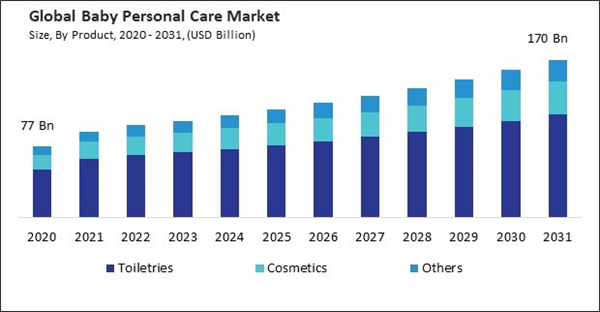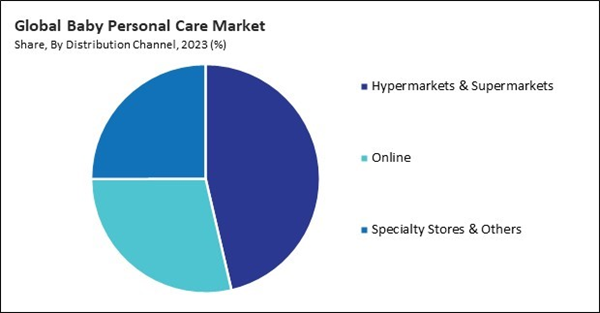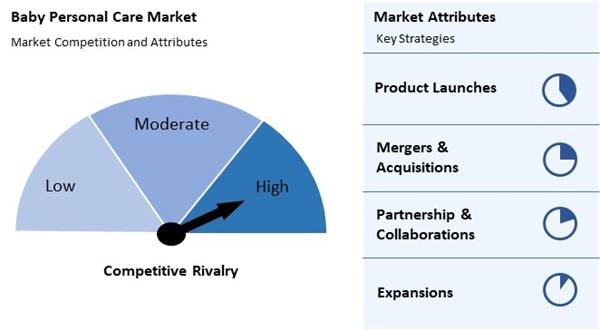The Global Baby Personal Care Market size is expected to reach $170 billion by 2031, rising at a market growth of 6.4% CAGR during the forecast period. In the year 2023, the market attained a volume of 20,377.8 million units, experiencing a growth of 12.2% (2020-2023).
The Asia-Pacific region has some of the highest birth rates in the world, leading to a large population of babies and young children. Therefore, the Asia Pacific region will capture around 40.4% share in the market by 2031. With a sizable young population, there is naturally a higher demand for baby personal care products. In addition, economic growth in countries across the Asia-Pacific region has led to an expansion of the middle class and an increase in disposable income. Moreover, total consumption of baby personal Care products in China was 2,763.6 million units in 2023.
The major strategies followed by the market participants are Product Launches as the key developmental strategy to keep pace with the changing demands of end users. For instance, In July, 2023, Himalaya Wellness Company unveiled Crème Cleansing BABY BAR, addition to its personal care products. The new product maintains the pH balance and safeguarding the acid mantle, the skin's primary defense. Additionally, In November, 2022, Procter & Gamble Company introduced upgraded Pampers Swaddlers. The new product would be available with a patented back waist cuff, front waistband, dual-leak guard barriers, lock-away channels, and an absorbent top sheet, which effectively prevents leakage.
Rising disposable income allows parents to allocate more resources to baby care products, including personal care items such as diapers, wipes, skincare products, and baby grooming essentials. With more disposable income, parents are willing to invest in high-quality, premium products that offer their babies superior safety, efficacy, and convenience. Thus, increasing disposable income and urbanization are propelling the market’s growth.
The market competition in the Baby Personal Care Market is robust, characterized by the presence of numerous multinational corporations, regional players, and new entrants vying for market share. Several factors contribute to the intense competition in this market segment, including changing consumer preferences, regulatory requirements, product innovation, and marketing strategies. Brand recognition and reputation also play a significant role in driving competition, with established brands leveraging their strong presence and consumer trust to maintain market dominance.
The Asia-Pacific region has some of the highest birth rates in the world, leading to a large population of babies and young children. Therefore, the Asia Pacific region will capture around 40.4% share in the market by 2031. With a sizable young population, there is naturally a higher demand for baby personal care products. In addition, economic growth in countries across the Asia-Pacific region has led to an expansion of the middle class and an increase in disposable income. Moreover, total consumption of baby personal Care products in China was 2,763.6 million units in 2023.
The major strategies followed by the market participants are Product Launches as the key developmental strategy to keep pace with the changing demands of end users. For instance, In July, 2023, Himalaya Wellness Company unveiled Crème Cleansing BABY BAR, addition to its personal care products. The new product maintains the pH balance and safeguarding the acid mantle, the skin's primary defense. Additionally, In November, 2022, Procter & Gamble Company introduced upgraded Pampers Swaddlers. The new product would be available with a patented back waist cuff, front waistband, dual-leak guard barriers, lock-away channels, and an absorbent top sheet, which effectively prevents leakage.
Cardinal Matrix - Market Competition Analysis
Based on the Analysis presented in the Cardinal matrix; Johnson & Johnson is the forerunner in the market. In July, 2022, Johnson & Johnson introduces a line of skincare and haircare products 'Vivvi & Bloom 2-in-1 Wash & Shampoo Cleansing Gel',' Vivvi & Bloom 2-in-1 Face & Body Whip Lotion', 'Vivvi & Bloom 2-in-1 Scalp & Body Massage Oil' designed for infants and toddlers. These products are EWG-certified and are free from parabens, sulphates, dyes, phenoxyethanol, silicones, or phthalates. Companies such as The Procter and Gamble Company, L'Oreal S.A., Unilever PLC are some of the key innovators in the market.Market Growth Factors
Parents are becoming increasingly conscious of the importance of maintaining proper health and hygiene practices for their babies. Parents are becoming more conscious of the possible risks of poor hygiene habits because they can access information through various sources, such as social media, parenting websites, and medical specialists. Hence, increasing awareness of baby health and hygiene drives the market’s growth.Rising disposable income allows parents to allocate more resources to baby care products, including personal care items such as diapers, wipes, skincare products, and baby grooming essentials. With more disposable income, parents are willing to invest in high-quality, premium products that offer their babies superior safety, efficacy, and convenience. Thus, increasing disposable income and urbanization are propelling the market’s growth.
Market Restraining Factors
Developing safe and effective products requires extensive research and testing to ensure compliance with regulatory standards and safety requirements. This includes conducting clinical trials, dermatological testing, and allergen assessments to assess product safety and efficacy. The costs associated with research and testing can be substantial, particularly for innovative formulations or advanced technology-driven products. In conclusion, high product development costs are impeding the market’s growth.Distribution Channel Analysis
Based on distribution channel, the market is segmented into specialty stores, hypermarkets & supermarkets, online, and others. The specialty stores segment attained 25.1% revenue share in the market in 2023. Specialty stores often specialize in baby products, including personal care items, and employ knowledgeable staff. Moreover, in terms of volume, the specialty stores segment attained 3,805.8 million units in the market in 2023.Product Analysis
On the basis of product, the market is segmented into cosmetics, toiletries, and others. The cosmetics segment recorded 20.3% revenue share in the market in 2023. With increasing disposable income levels in many regions, parents are more willing to spend on premium baby care products, including cosmetics, which are perceived as safer and of higher quality. Moreover, in terms of volume, the cosmetics segment registered 3,162.4 million units in the market in 2023.By Regional Analysis
Region-wise, the market is analysed across North America, Europe, Asia Pacific, and LAMEA. The European region generated 26.7% revenue share in the market in 2023. Parents in Europe are becoming more conscious of the ingredients and formulations used in baby products. There is a growing preference for natural and organic options, as well as products that are free from potentially harmful chemicals. Moreover, in terms of volume, the consumption of baby personal care products in the Germany Market was 1,216.8 million units in 2022.Market Competition and Attributes
The market competition in the Baby Personal Care Market is robust, characterized by the presence of numerous multinational corporations, regional players, and new entrants vying for market share. Several factors contribute to the intense competition in this market segment, including changing consumer preferences, regulatory requirements, product innovation, and marketing strategies. Brand recognition and reputation also play a significant role in driving competition, with established brands leveraging their strong presence and consumer trust to maintain market dominance.
Recent Strategies Deployed in the Market
- Feb-2024: Avon Products, Inc. came into partnership with Cotton made in Africa (CmiA), an internationally recognized standard for sustainable cotton from Africa. The company would integrate CmiA-certified cotton into its product range, including women’s nightwear, as a key component of its sustainability initiative. In addition to utilizing sustainably sourced raw materials, the company aimed to attain certification and establish traceability, addressing both environmental and social considerations for products containing cotton.
- Jan-2024: Pampers, a baby care brand under the Procter & Gamble umbrella, launched its enhanced Premium Care Diapers for babies. This latest range features an integrated anti-rash blanket and aloe vera-infused lotion, designed to safeguard the delicate skin of infants from irritation.
- Jul-2023: Himalaya Wellness Company unveiled Crème Cleansing BABY BAR, addition to its personal care products. The new product maintains the pH balance and safeguarding the acid mantle, the skin's primary defense.
- Dec-2022: Beiersdorf AG took over S-Biomedic NV, Belgium, a life-science company. With this acquisition, the company aimed to create opportunities to innovate products that synergize with the natural processes of the skin.
- Dec-2022: Beiersdorf AG took over Chantecaille Beaute Inc., a US-based personal care product manufacturing company. Through this acquisition, Beiersdorf AG would expand its global market presence and product portfolio.
List of Key Companies Profiled
- L'Oreal S.A.
- Dabur India Ltd.
- Abbott Laboratories
- Unilever PLC
- The Procter & Gamble Company
- Kimberly-Clark Corporation
- Johnson & Johnson
- Beiersdorf AG
- Himalaya Wellness Company (Himalaya Global Holdings Ltd.)
- Avon Products, Inc. (Natura &Co Holding S.A.)
Market Report Segmentation
By Product (Volume, Million Units, USD Billion, 2020-2031)
- Toiletries
- Cosmetics
- Others
By Distribution Channel (Volume, Million Units, USD Billion, 2020-2031)
- Hypermarkets & Supermarkets
- Online
- Specialty Stores & Others
By Geography (Volume, Million Units, USD Billion, 2020-2031)
- North America
- US
- Canada
- Mexico
- Rest of North America
- Europe
- Germany
- UK
- France
- Russia
- Spain
- Italy
- Rest of Europe
- Asia Pacific
- China
- Japan
- India
- South Korea
- Australia
- Malaysia
- Rest of Asia Pacific
- LAMEA
- Brazil
- Argentina
- UAE
- Saudi Arabia
- South Africa
- Nigeria
- Rest of LAMEA
Table of Contents
Chapter 1. Market Scope & Methodology
Chapter 2. Market at a Glance
Chapter 3. Market Overview
Chapter 4. Competition Analysis - Global
Chapter 5. Global Baby Personal Care Market by Product
Chapter 6. Global Baby Personal Care Market by Distribution Channel
Chapter 7. Global Baby Personal Care Market by Region
Chapter 8. Company Profiles
Companies Mentioned
- L'Oreal S.A.
- Dabur India Ltd.
- Abbott Laboratories
- Unilever PLC
- The Procter & Gamble Company
- Kimberly-Clark Corporation
- Johnson & Johnson
- Beiersdorf AG
- Himalaya Wellness Company (Himalaya Global Holdings Ltd.)
- Avon Products, Inc. (Natura &Co Holding S.A.)
Methodology

LOADING...











